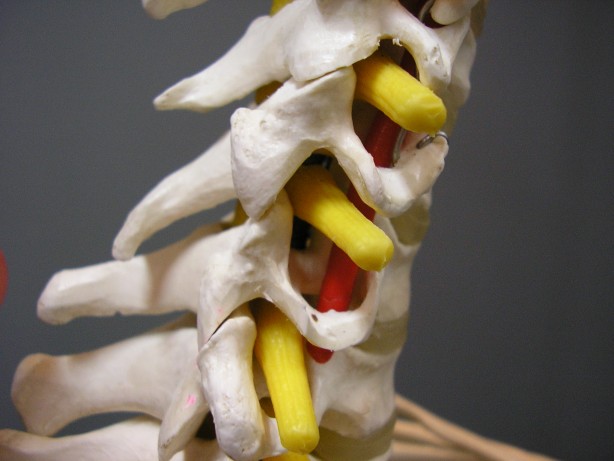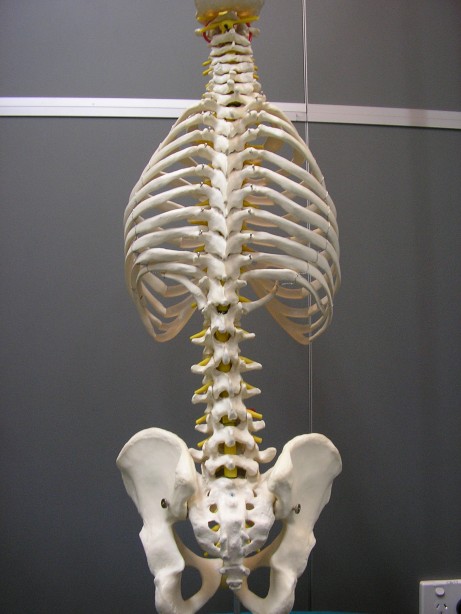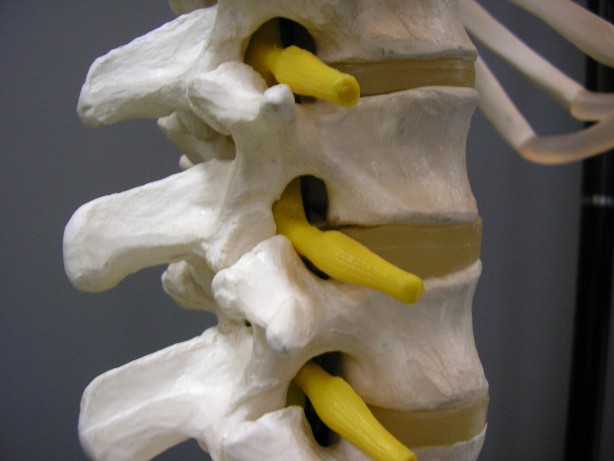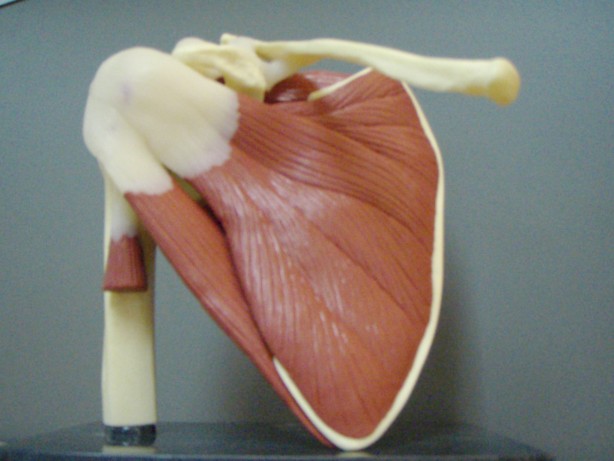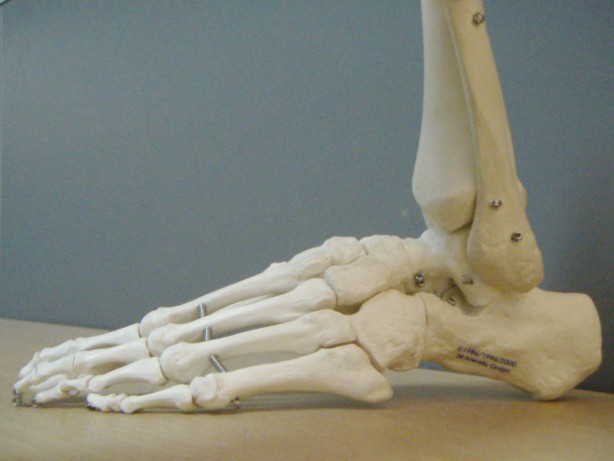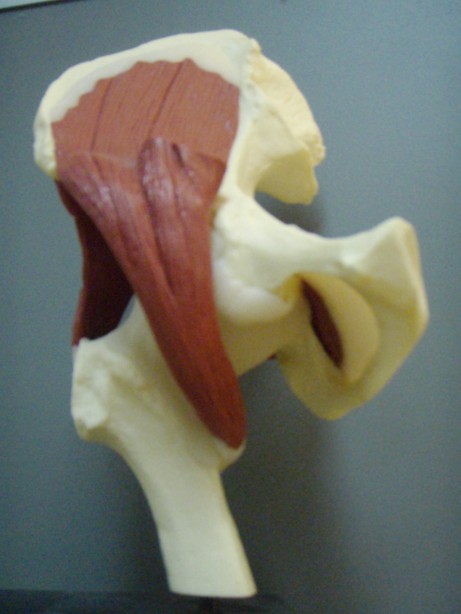About Pain
Sports Injuries | Chronic Pain | Spinal Conditions | Nerve Pain
- Why does the topic of pain have so much varied, and sometimes conflicting, information?
- Why is pain such a severely debilitating and prolonged problem for some, with a huge variation of opinions on what to do about it?
- Research shows that ~45% of the population are suffering musculoskeletal pain. What does this tell us about the majority of management methods?
- Can there be a better way to see the underlying cause of pain, and therefore manage it more effectively?
|
Nerves (yellow) carry signals |
It may surprise you to read that the common understanding of how pain arises has recently been shown to be inaccurate. Might this be why pain and injuries are a huge challenge for so many people? If we have a more clear, and more accurate, understanding of pain and other symptoms*, might this lead to faster solutions and better management of nearly all musculoskeletal conditions? This topic is presented with the intention that you might also be able to make a big difference to your pain, or someone you know who experiences pain, with a more accurate and more simple understanding of pain. |
Warning!
Some of the concepts presented below are very different to some long-standing beliefs in the medical, physiotherapy and health world. While initially this may be challenging for some, overall this can be seen as a positive… as progress requires change.
In other words, if much better results can be achieved much faster with a different way of thinking, is it worth changing old thoughts about pain?
The number one misunderstanding about pain:
- That pain is a feeling.
There is growing body of neuroscience and physiotherapy research that is making it very clear that pain is not a feeling.
This research has clearly shown that there are no 'pain receptors', no 'pain signals' from the tissues, no tissues ‘feel’ pain and there is no pain ‘in’ any body part.
This insight is very helpful to directing our attention to the factors that need to be fixed to get rid of pain.
What does the latest research explain?
Pain is actually created by the brain - for good reasons.
- Understanding that pain is created by the brain allows us to focus on fixing the structures everywhere and anywhere in the body that are the underlying cause of our brains creating the pain
- This sometimes means that treating areas different to where the pain is created is the best way for most rapid and long-lasting results
Why is this such an important differentiation? |
|
|
These signals tell the brain |
This differentiation allows us to understand what is required to resolve pain most quickly. If we accept that pain is not a feeling, should we try to fix the problem by solving the pain? Imagine the scenario of a car that is malfunctioning with a bright engine warning light on the dash. Is it sensible to think that we can fix the problem by doing something to the warning light? Or would it be more sensible to acknowledge the warning light and then check out every possible structure that could be causing a problem to the car’s engine? Recent studies teach us that pain is the brain's equivalent of a dashboard warning light1. When we stop to think about it this makes a lot of sense and this way of thinking fits all types and scenarios of painful conditions. In other words, this way of thinking appears to be the simplest and most ‘true’ way to understand pain. This warning light analogy is a simplification because the body’s the warning light, i.e. pain & symptoms can be created by the brain as an experience 'in' any part of the body for any problem anywhere in the body. Taking into account these variations, the principle of a creation of a warning signal is incredibly helpful. For example, it may be that when you hit your thumb with a hammer, the warning signal produced by the brain creates an experience like is pain 'in' the thumb - and usually this is a very successful protective mechanism that results in moving the thumb out of it's dangerous position to prevent further damage. Or it may be that injury occurs in the spine and the warning signal produced by the brain creates a pain-experience 'in' a limb (or vice versa). This way limping, or stopping walking, is a protective mechanism to stop strain to the spine - because the leg hurts.
It is important to note that this way of thinking does not lesson the significance of pain. On the contrary, it actually validates how important pain is as a warning signal. Pain is a very important indicator to for us to pay attention and change what we are doing to protect us from harm. The brain is very smart and at least one step ahead of our consciousness. This is fundamentally a good thing because if we relied on our conscious awareness to avoid danger we would not do as well at protecting ourselves. For a start, our conscious awareness is too slow and distractible to respond effectively; and secondly, it would be too easy to consciously 'override' the warning by continuing our preferred activity despite the damage... until it's really too late. |
|
After the brain receives the signals |
|
|
This way of thinking about pain does mean that we need to rely on atypical means of solving why the pain is occurring - to fix the problem most effectively. |
|
So what is going on for the brain to create pain? |
|
|
The response may be a protective mechanism of PAIN |
We know that nerves carry impulses, or signals, from the body’s tissues that tell the brain about the state of the tissues. Information such as excessive stretch, excessive strain, over-compression, tearing, bleeding, swelling etc. (both physical and chemical noxious signals) are transmitted to the brain indicating a ‘less-than-optimal' state, or an 'unhappy' state. This all happens in our subconscious - we aren't aware of it. This newest, and RM, way of thinking is that once the brain receives these signals then the subconscious brain decides on best approach to protect the body. If the brain perceives these signals beyond a threshold and ‘bad enough’, then one of the brain’s protective reactions is to create the experience of pain and/or symptoms and make us conscious of needing to avoid damage. Without this protective response we would be much more likely to do more severe damage to ourselves, and for this reason pain is a very successful protective mechanism. |
This protective response can be very different in different people, even with the same unhappy (noxious) signals. Experience and research tells us that our individual brains are so different they can choose to produce a protective reaction, such as the type and location of the pain, that is individual to each of us.
On the other hand, if the brain perceives these signals are under the threshold and ‘not bad enough’ then we remain completely unaware of any problem. This whole process occurs at a subconscious level – and this happens every day to all tissues in our body as a natural process.
- For example, it is well accepted that nearly all body parts are continually remodeling, and ‘wearing out’, and injured cells are being replaced without us knowing about it, with an average turn-over for all cells in most body parts of about 7 years. The brain decides this low-level of signal is not significant enough to create a warning of pain (thankfully!).
How does this understanding help solve pain faster? |
|
|
The PAIN can be created to be experienced anywhere in the body |
Let’s go back to the example of the faulty car and the dashboard warning light. How good would it be for all the parts of the car, which might relate to the dysfunctioning engine, to be tested to see which ones are faulty? How good would it be to fix the faulty part, and know how to check this for yourself at regular intervals in the future? What might happen to the dashboard warning light if you took this approach? Clearly, this would result in the warning light going off and staying off. Plus, this would result in an optimal performance of the car. This analogy fits the human body. How good would it be if your warning signal, i.e. pain, alerted you to get every part of your body tested+ that could relate to your problem to find out which ones might be faulty? |
The next step is clear – fix the faulty part wherever it is – and when the most significant fault of the problem is fixed… then the pain goes away! i.e. the warning signal is no longer required to be ON. The bonus is that the body then functions at its highest performance.
And the next step after that is highly valuable. Self checking that faulty part in the future and ensuring it remains in good shape is the best way of preventing recurrence.
It even gets better than that… for proactive people, the faulty part can be tuned-up, before the warning signal comes on, i.e. before any pain occurs! Many people are this proactive with their car, and this proactive with their teeth, and their general health with a GP, imagine how much easier, and less expensive in the long run, it would be if we all learned to be this proactive for our musculoskeletal body parts.
It is important to note that the vast majority of musculoskeletal condition’s ‘faulty parts’ are quickly fixable. We know from regular experience that the human body has an amazing capacity to change very quickly. Rebalancing unevenly distributed forces (even on warn body parts); releasing tension from strained areas; loosening stiff joints and supporting lax body parts can be rapidly changed (immediately in some and within a few sessions for most) for the vast majority of conditions.
We certainly hope this brief introduction to the most recent understanding of pain makes as much sense to you as it does to us. Please let us know if you would like more information.
Do you want to change your thoughts about pain and the process required for a rapid solution?Do you want to experience a different approach for solving a musculoskeletal** problem?Would you like to proactively manage your body and optimise your performance at the same time? |
|
|
Solving the dysfunction in the muscles, joints, nerves and bones means the brain no longer receives (noxious) signals of an unhappy state of the tissues - the result is there is no reason for the brain to create PAIN. |
If you answer YES to any of these questions you are in good hands with a Ridgway Method Certified Practitioner to learn how. This problem solving process for pain requires a lot of technical skill, a lot of individual personal attention, including advanced problem solving and advanced testing methods; and the principle is simple when a good practitioner knows why and how to do it. All Ridgway Method Certified Practitioners understand this process and follow unique and standardised problem solving system to most rapidly test and solve musculoskeletal dysfunctions for faster results, and best prevention of pain. Do you also know someone else who might also like to learn of this unique information? If Yes, please send them the link to this page.Please feel free to ask questions about the material presented. 1One of the most significant researchers in the world that leads to the information presented here is G. Lorimer Moseley, an Australian: the author of Painful Yarns - Metaphors & Stories to help understand the biology of pain. *Specifically musculoskeletal pain symptoms: these include sharp pain, ache, deep pain, superficial pain, shooting pain, stabbing pain, lines of pain, points of pain, vague pain, pins and needles, burning pain, feeling of numbness, tingling, crawling-under-the-skin, feeling of tightness, deadness, heaviness…and many more. **Musculoskeletal = joints, muscles, nerves & bony conditions. +While this information focuses on the physical body parts we can test, there are also important mental 'body parts' for us to test. Commonly; thoughts, feelings and actions can be the 'faulty part' that needs to be changed and treated. When these are the most important 'structures' to treat and they are changed, then the pain (and body compensations) are not produced, the problem is fixed, and pain is not created by the brain.
|














